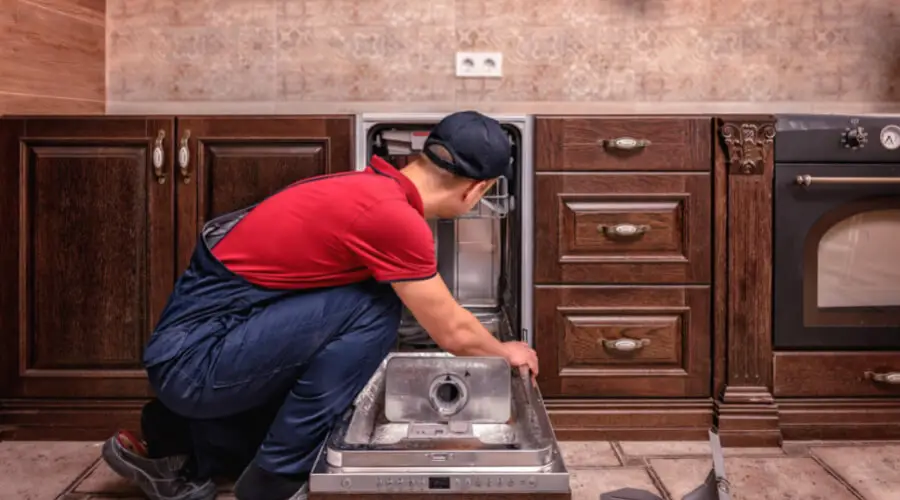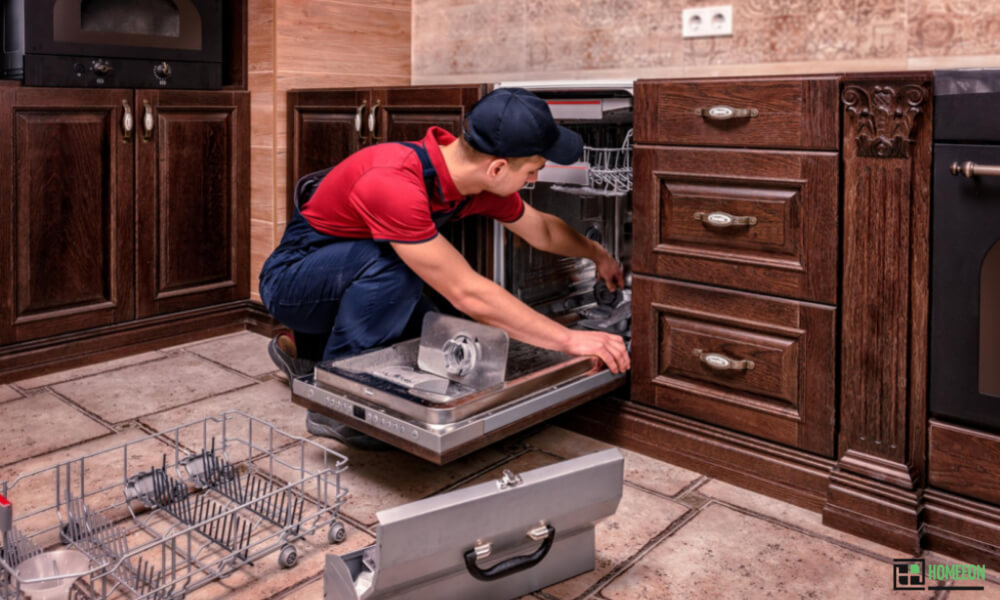Last Updated on July 30, 2023 By Emma W. Thomas
To reset a KitchenAid dishwasher follow these steps:
- Locate the control panel or display.
- Press the “Start/Resume” or “Cancel/Drain” button to interrupt the current cycle.
- Wait for a few seconds.
- Press and hold the “Control Lock” or “High-Temp” button for 3-5 seconds until the control panel lights blink.
- Release the button; the dishwasher is now reset and ready for use.
Steps Of Resetting KitchenAid Dishwasher

Manual Reset Of A Dishwasher
Step 1: Unplug your dishwasher from the power source
If the dishwasher is not responding to commands, unplug it from the power source. Leave it unplugged for about 5 minutes for its system to reset. Leaving the dishwasher longer won’t do any harm.
For the dishwasher connected directly to the power source, please turn off the breaker for your house or room for about five minutes before turning it on.
Step 2: Plug the dishwasher back to the power source
After 5 minutes, reconnect your machine to the power source and check if all the errors have been cleared. If there are still error codes or flashing lights on the panel, give the dishwasher 5-10 minutes before checking again. Sometimes the errors still appear as the system has not completed running diagnostic tests or re-computing.
If the error code doesn’t clear, check your manual to understand what to do next. If, after trying, there is no indication, such as flashlights, that the dishwasher is working well, proceed to reset the control panel.
Step 3: Press the ‘heat dry’ and ‘normal’ buttons to run a test cycle
After disconnecting and connecting the dishwasher back to a power source, it is best to run a test cycle before loading it. Press the ‘heat dry’ and ‘normal’ buttons and wait for the display to light up. Once all the lights are illuminated press start to run the test cycle. If it runs successfully, it assures you that everything is working well before you load your machine.
Some KitchenAid models will require you to press the first three buttons in sequence, starting from the left. Do it three times and then press start to run the test cycle.
If an error code appears during the test cycle, it means there are still issues with the dishwasher. Check the manual and continue troubleshooting the problems.
Resetting The Control Panel
Step 1: Press the ‘hi-temp and ‘dry’ buttons five times
If your machine could not run the test cycle successfully after a manual reset, it is time to reset the control button itself. Check that the machine’s door is latched and closed fully, and then press the ‘hi-temp and ‘dry’ buttons one after the other five times.
In some models, the buttons are labeled ‘hi-temp scrub’ and ‘energy saver dry,’ respectively. After pressing the buttons 4-5 times, the dishwasher will reset.
Step 2: Let the dishwasher rest for 5-10 minutes to reset
After pressing the reset buttons successfully, all the lights will flash on the display panel with a whirring noise from the machine. Leave the dishwasher untouched for 5-10 minutes to re-compute and run a diagnostic test. The process can take more than 10 minutes, so you should wait until no noise comes and no flashlights on the display panel.
Step 3: Press the drain or cancel button to complete the reset
Pressing the drain or cancel button activates a 2-minute drain cycle. Do not open the dishwasher until this cycle is complete. This process solves most of the programming and error issues as it reboots the entire system.
However, if your device still has problems after resetting the control panel, you can consider further troubleshooting. Sometimes, if not successful, it is best to call a repair technician. It could be you are dealing with actual broken parts which cannot be fixed through resetting.
Reasons for Resetting a KitchenAid Dishwasher
You may need to reset a KitchenAid dishwasher for various reasons, including:
- Cycle Interruption: To cancel or stop a current cycle and start a new one.
- Error Codes: To clear error codes or resolve issues with the dishwasher’s operation.
- Power Outage: After a power outage, resetting helps restore normal functioning.
- Calibration: Some models may require a reset after maintenance or calibration adjustments.
- Troubleshooting: As part of the troubleshooting process for resolving performance or functionality problems.
- Control Lock: Resetting can unlock the control panel if it’s accidentally locked.
Problems That Can Cause KitchenAid Dishwasher Not To Work Properly And How To Troubleshoot
Engaged Child’s Lock Or Control Lock
The dishwasher won’t turn on if the child’s lock or control lock is engaged. Note that it can get selected accidentally, and it is good to check if the light underneath the lock button is on. If it is lit up, turn it off by holding the ‘lock’ button for four seconds.
N/B: You can always activate the lock function for the safety of your kids. That way, the children will not be able to push other buttons or open the dishwasher.
Dishwasher Door Not Properly Latched Or Closed
A door that is not properly latched or locked will prevent the dishwasher from working well. If the bottom rack is not completely in place or some utensils are not organized well, it could keep the door from latching. Press the shutter button, and if the door latches and closes well, you should hear a clicking. If not, and you could not pinpoint the issue, it could be the latch needs replacement. Inspect if there is physical damage and call a repair technician to fix it for you.
‘Delayed Wash’ Option Engaged
As the name suggests, the delayed wash option means that the wash is postponed based on your setting. If engaged, the dishwasher will not start to work immediately. Cancel the option by pressing the drain/cancel button and then resume/start the function to begin the normal cycle.
Complex Problems
Your dishwasher might not be working because of issues to do with the computer board or actual fuse. You might not be able to troubleshoot the issues, and you should call an expert repair technician for help. Broken parts need replacement as it cannot be fixed by resetting the machine.
Do KitchenAid Dishwashers Have A Reset Button?
KitchenAid dishwashers don’t have one specific ‘reset’ button and can only be reset by pressing a series of other buttons in a particular sequence. You will have to press the ‘hi-temp and ‘dry’ buttons five times, then give the machine time to reset. After around 10 minutes, press the drain or cancel button to complete the reset.
Why Is My KitchenAid Dishwasher Not Draining?
Some of the issues that can cause your dishwasher not to drain include:
Defective Drain Pump
The drain pump propels water through the dishwasher’s drain hose. Any defect would mean there would be water at the bottom of your machine. Since the pump is not repairable, you will have to buy a new one to replace it.
Clogged Garbage Disposal
When the garbage disposal is clogged, your dishwasher will not drain. To check and clear the clog, unplug it first. Detach the drain hose and wash all the disposal fittings plus the hose.
Remove the clogs from the disposal housing by opening the grinder from the bottom using an Allen wrench.
If the garbage disposal is connected directly to your dishwasher, check that the plugin of the hose is removed for the dishwasher to work properly.
Clogged Drain Valve
The drain valve easily gets clogged as this is where the food particles are filtered. Consequently, the dishwasher will not drain until you clean out the valve for water to flow well. If it is not clogged after inspecting the valve and still cannot work, you will have to replace it.
Clogged Drain Hose
There will be no proper drainage if the drain hose is clogged. Remove the hose from the sink drain and dishwasher and wash it thoroughly. Check the garbage disposal and drain branch as most clogs settle there. Clean them thoroughly, and the machine should drain properly.
Why Does My KitchenAid Dishwasher Start And Stop?
Faulty motors or tripped circuits are major reasons for a dishwasher to start and stop unexpectedly. Frequent use and old age can also cause the dishwasher components to wear out, become damaged, or break due to wear and tear. However, you can troubleshoot the problems by following the steps below:
- Check that the door has latched properly
- Inspect if the thermal fuse is blown
- Test the electronic control board, fan assembly, and lid switch assembly
- Inspect the pump and motor and test if they are working normally
- Test for continuity of the dishwasher timer
- Check if the water is flowing continuously through the inlet valve
- If there are issues and troubleshooting doesn’t solve, call a repair technician for help.
Final Word
Life without a dishwasher can be hectic but even more stressful if you own a machine that doesn’t work properly. Of course, the first thing that crosses your mind is resetting and seeing if it works well. You can reset it manually by disconnecting the dishwasher from the power source, giving it a few minutes, and then connecting it back. If that doesn’t solve the issues, reset the control panel accordingly. Otherwise, check for other problems that can cause your KitchenAid dishwasher to misbehave and call a repair technician if need be.
References:
https://storables.com/articles/how-to-reset-a-kitchenaid-dishwasher/
https://howdykitchen.com/how-to-reset-a-kitchenaid-dishwasher/
Emma is a graduate of Domestic Science or Family and Consumer Sciences (Home Economics) from the University of Wisconsin. She has 7 years of experience Working with the strategic section of BestBuy and now writing full-time for Homeeon.
From Managing the Home, Interiors, Cleaning, and Exteriors to Gardening and everything about Making A Home Liveable – is her passion and this Homeeon is the result of this.
Emma loves decorating her home with the best stuff found online. She cares about quality over anything and writes reviews about them here in Homeeon. Get in touch with her over Pinterest.
Keep reading her blogs.

